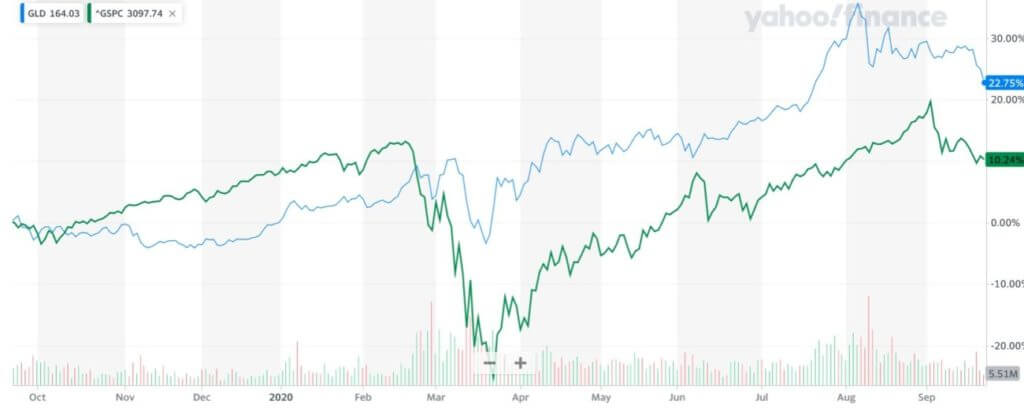3 Key Reasons Why Gold’s Price Has Suddenly Plunged

A stronger dollar, lower inflation expectations, and a drop in market fear have all conspired to send gold prices lower. | Image: DAVID GRAY / AFP
- The U.S. dollar’s sudden surge has sent gold prices back under $2,000 per ounce.
- Lagging economic data also point to lower gold prices.
- Declining market fear and inflation expectations will also push gold prices down.
Gold has been one of the top performers of the year, but this week it’s selling off heavily. Several factors have confluence at just the right time to provide the metal with its biggest selloff in the past year.
Gold’s Outperformance of Stocks Could Be Ending
Over the past year, gold prices have surged nearly 25%. That’s on top of gains the metal has shown since 2016 . In the same period, stocks have dealt with a swift and massive bear market.

Stocks are now up only 10% in the past year, meaning gold has been a strong outperformer.
That performance was driven by several factors that may now work against gold. During the market selloff, gold held up much better, as investors took money out of stocks and put it into bullion. The metal’s price got a boost as new Fed stimulus during the market crash pushed the U.S. dollar lower.
Now, that trend is reversing. Against expectations, the dollar is rising . That’s the biggest factor sending gold lower right now. Why? Because gold is priced in dollars; investors also treat it as an anti-dollar (or any other fiat currency, really).
Dollar’s Move Will Impact All Asset Classes
Not only has the dollar moved higher, but it’s also now at a two-month high. It has broken its 50-day moving average, a technical signal that its recent move will continue.

All assets priced in dollars–from gold and oil to stocks–can be impacted. A stronger dollar makes U.S. goods more expensive abroad, which could weigh on corporate earnings. So, it’s no surprise to say that the dollar trend is a lot more than just gold.
As for the yellow metal, part of its move has been based on rising inflation expectations . That made sense as the economy was in a rapid recovery mode earlier in the year, but now the latest economic information shows that the economy is starting to stall. That may explain why some funds began to take profits in gold.
The latest manufacturing purchasing managers index (PMI) data , for instance, shows a reading of 53.5. That’s a trend of slight growth overall despite being a 20-month high.

For inflation expectations to rise, the index would need to be in the 60s or higher for a prolonged period. For now, there’s barely any growth after record drops in April and May.
Finally, stock markets have shaken off fears of another major decline. Gold tends to hold up well during periods of fear , and even with all the central-bank activity, which should put a price under the metal, that just isn’t happening.
Between a stronger dollar, lower inflation expectations from a flatlining economy, and a drop in market fear, it’s been a perfect storm for gold prices to decline. It won’t last forever, but it will likely continue.
Disclaimer: The opinions expressed in this article do not necessarily reflect the views of CCN.com and should not be considered investment or trading advice from CCN.com. The author owns gold and gold mining stocks.